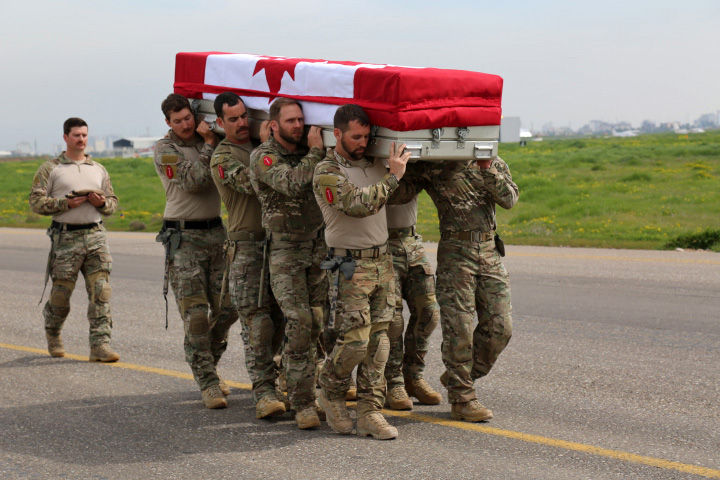Sergeant Andrew Joseph Doiron: A Canadian Special Operation Legacy
- canadaswarpath
- Apr 7
- 4 min read
Sgt Andrew Joseph Doiron was not a household name, but among the Canadian Armed Forces and the soldiers who served beside him, his legacy stands as a testament to courage, professionalism, and dedication.
Born on May 3, 1983, in Moncton, New Brunswick, Andrew Doiron grew up with a quiet sense of determination. Friends and family describe him as intelligent, reserved, and thoughtful, someone who carried himself with quiet confidence. From a young age, he demonstrated a sense of duty, which would eventually lead him to military service.
On December 18, 2002, at the age of 19, Andrew enlisted in the Canadian Armed Forces. He entered a world few Canadians ever truly see, one that demanded excellence, resilience, and total commitment. Over the years, he earned the respect of his peers and superiors, rising through the ranks not just because of skill, but because of his unwavering work ethic and steady leadership.

Eventually, Andrew took a path few are able to follow, he was selected to serve with the Canadian Special Operations Regiment, or CSOR. This elite unit, formed in 2006, is part of Canada’s special operations forces, designed for complex, high-risk missions both at home and abroad. Selection is rigorous. Training is relentless. But Andrew passed. And he became one of the best.
Those who served alongside him speak of his professionalism. He was not someone who sought the spotlight. He focused on the mission, on the team, and on the responsibility that came with wearing the uniform. In the world of special operations, where failure is not an option, Andrew Doiron stood out as a model soldier.
In recognition of his service, he received the Canadian Forces’ Decoration, an award given to members of the Armed Forces who complete twelve years of honorable service. But Sergeant Doiron’s story, like so many, would be defined not just by what he achieved, but by what he gave.

In early 2015, Andrew Doiron deployed to Iraq as part of Operation IMPACT, Canada’s contribution to the international coalition against the Islamic State of Iraq and the Levant (ISIL). His role was both strategic and dangerous: Canadian special operations forces were tasked with training, advising, and assisting Kurdish Peshmerga fighters near the front lines.

The work was crucial and risky. These were not combat operations in the traditional sense, but the line between advisor and front-line soldier often blurred. Canadian troops operated in proximity to enemy forces, providing real-time assistance to their Kurdish partners. It required discipline, precision, and strong communication.
On March 6, 2015, during one of these operations, Sergeant Doiron and his team were returning to a Kurdish observation post. They had coordinated their movement in advance, but a miscommunication with a new rotation of Kurdish fighters proved catastrophic. As the Canadians approached, they were mistaken for enemy forces. Kurdish soldiers opened fire.
In the confusion, Andrew was fatally wounded. Three other Canadians were injured in the incident.
The tragedy sent shockwaves across Canada. It was the first Canadian military fatality in Operation IMPACT and a painful reminder of the risks taken daily by those in uniform. An investigation later confirmed that Sergeant Doiron and his team had followed proper protocol. They had done everything right. The error stemmed from a breakdown in communication among local forces, including an uncommunicated shift change at the observation post.
Following the incident, tributes poured in from across the country. General Tom Lawson, then Chief of the Defence Staff, expressed deep sorrow, saying: “This is a tragedy beyond words.” Brigadier-General Michael Rouleau, Commander of the Canadian Special Operations Forces Command, described Doiron as “a gifted special operator and a great leader,” someone who made a lasting impact within the elite unit and the broader Canadian military.
On March 11, 2015, Sergeant Doiron’s body was repatriated to Canada. Along the Highway of Heroes, an unofficial route between Trenton and Toronto, citizens gathered on overpasses to pay their respects, holding flags and saluting as the convoy passed. It was a powerful display of national mourning, and a reminder that behind every uniform is a person who gave everything.

Sergeant Andrew Doiron was laid to rest at Beechwood Cemetery in Ottawa, in the Veterans’ section, a place reserved for those who served the nation with distinction. His name is now engraved in the In the Service of Canada Book of Remembrance, housed in the Memorial Chamber of Canada’s Parliament Buildings.
He was 31 years old.
Andrew’s sacrifice is commemorated every year during Remembrance Day, not just as a statistic or a name, but as a life lived in service to others. His loss also sparked deeper discussions within Canada’s military community about communication, friendly fire incidents, and the risks faced by special operations forces in modern warfare.
Sergeant Andrew Doiron’s legacy lives on in those who trained with him, fought beside him, and now follow in his footsteps. His story is a reminder that Canadian soldiers are not only peacekeepers, they are warriors, tacticians, and protectors, willing to place themselves in harm’s way so others might live in peace.
Andrew didn’t seek glory. He served with quiet strength and unmatched skill. His death was a tragedy, but his life was a powerful example of what it means to serve with honor.

Follow me on instagram and facebook for more contents





Comments